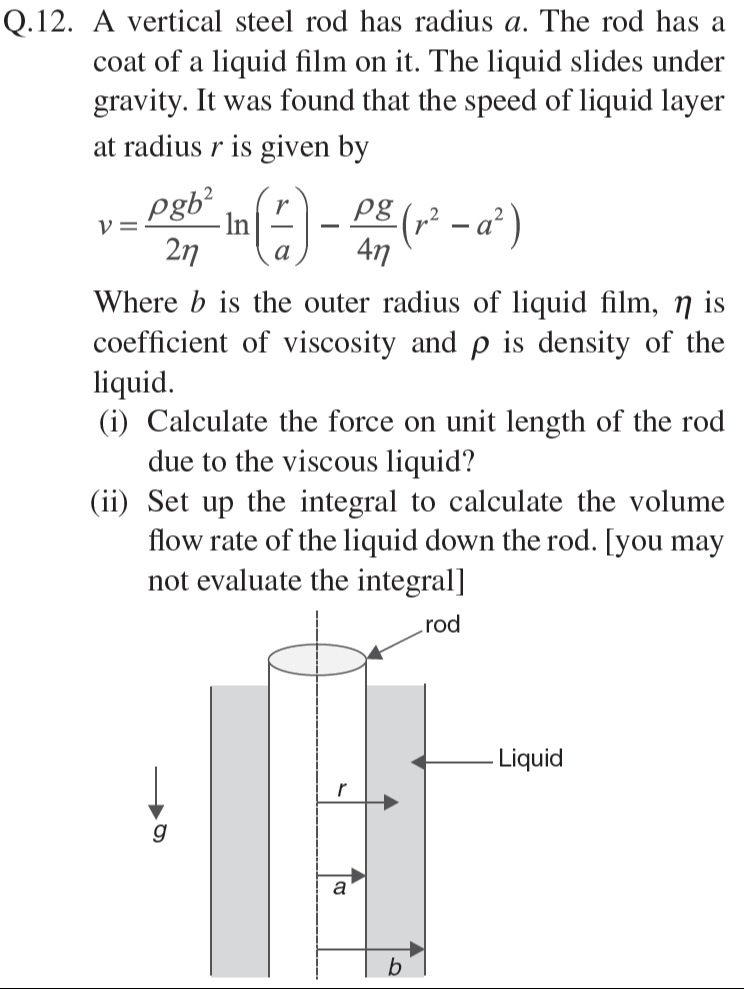Question
Question: A vertical steel rod has radius $a$. The rod has a coat of a liquid film on it. The liquid slides un...
A vertical steel rod has radius a. The rod has a coat of a liquid film on it. The liquid slides under gravity. It was found that the speed of liquid layer at radius r is given by
v=2ηρgb2ln(ar)−4ηρg(r2−a2)
Where b is the outer radius of liquid film, η is coefficient of viscosity and ρ is density of the liquid.
(i) Calculate the force on unit length of the rod due to the viscous liquid?
(ii) Set up the integral to calculate the volume flow rate of the liquid down the rod. [you may not evaluate the integral]

(i) Force per unit length = πρg(b2−a2) (downwards)
(ii) Volume flow rate = ∫ab[2ηρgb2ln(ar)−4ηρg(r2−a2)](2πr)dr
Solution
The problem involves the flow of a viscous liquid film down a vertical rod. We are given the velocity profile of the liquid and asked to calculate the force on the rod and set up an integral for the volume flow rate.
Part (i): Calculate the force on unit length of the rod due to the viscous liquid.
The force exerted by a viscous fluid is related to the shear stress (τ) at the surface. According to Newton's law of viscosity, the shear stress is given by: τ=ηdrdv where η is the coefficient of viscosity and drdv is the velocity gradient.
The given velocity profile is: v=2ηρgb2ln(ar)−4ηρg(r2−a2)
First, we need to find the velocity gradient drdv: drdv=drd[2ηρgb2(lnr−lna)−4ηρg(r2−a2)] drdv=2ηρgb2(r1)−4ηρg(2r) drdv=2ηrρgb2−2ηρgr drdv=2ηρg(rb2−r)
The force on the rod is due to the viscous liquid at its surface, which is at radius r=a. So, we evaluate the velocity gradient at r=a: (drdv)r=a=2ηρg(ab2−a)=2ηaρg(b2−a2)
Now, calculate the shear stress at the rod's surface (r=a): τa=η(drdv)r=a=η[2ηaρg(b2−a2)] τa=2aρg(b2−a2)
The force on unit length of the rod (F′) is the shear stress multiplied by the surface area per unit length. The surface area per unit length of the rod is its circumference, 2πa. F′=τa×(2πa) F′=[2aρg(b2−a2)]×(2πa) F′=πρg(b2−a2) Since the liquid is flowing downwards, and the rod is stationary, the liquid exerts a downward viscous force on the rod.
Part (ii): Set up the integral to calculate the volume flow rate of the liquid down the rod.
The volume flow rate (Q) through a cross-section is given by the integral of the velocity over the area of flow. The liquid flows in an annular region between radius a and b. Consider an elemental annular ring of radius r and thickness dr. The area of this elemental ring is dA=2πrdr. The volume flow rate through this elemental ring is dQ=v⋅dA=v(2πr)dr.
To find the total volume flow rate, we integrate dQ from the inner radius a to the outer radius b: Q=∫abv(2πr)dr Substitute the given expression for v: Q=∫ab[2ηρgb2ln(ar)−4ηρg(r2−a2)](2πr)dr
This is the required integral setup for the volume flow rate.
